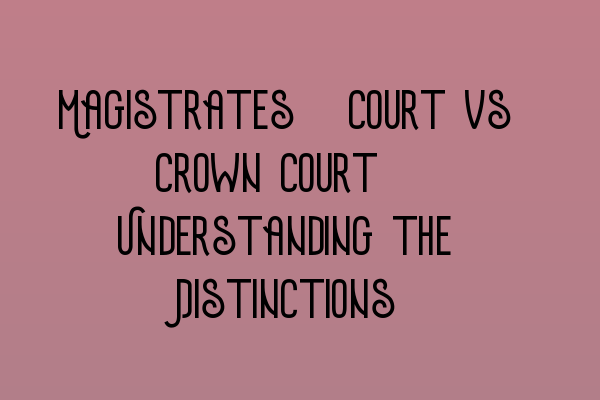Magistrates’ Court vs Crown Court: Understanding the Distinctions
When it comes to the criminal justice system in the UK, one of the most important distinctions to understand is the difference between the Magistrates’ Court and the Crown Court. Each court has its own jurisdiction, procedures, and sentencing powers. In this article, we will delve into these distinctions and shed light on the roles and functions of each court.
The Magistrates’ Court
The Magistrates’ Court, also known as the lower court, is the first point of entry for the majority of criminal cases. It handles less serious offenses, known as summary offenses, which include minor assault, theft, public order offenses, and traffic violations.
Magistrates, also referred to as justices of the peace (JPs), preside over the proceedings in the Magistrates’ Court. They are typically volunteers from the local community who have received training to fulfill their judicial duties.
In terms of procedure, the Magistrates’ Court follows a less formal process compared to the Crown Court. The accused, also called the defendant, does not have a right to a jury trial in the Magistrates’ Court. Instead, the magistrates themselves make decisions on guilt or innocence.
Sentencing powers in the Magistrates’ Court are limited. They can impose a maximum prison sentence of six months for a single offense (12 months for multiple offenses). However, in more complex cases or cases involving severe offenses, the Magistrates’ Court can transfer the case to the Crown Court for trial and sentencing.
If you are preparing for your SQE 1 exam, our SQE 1 Practice Exam Questions will help you test your knowledge and boost your confidence.
The Crown Court
The Crown Court is the superior court and deals with more serious criminal offenses. It conducts trials with a jury and has the power to hand down longer sentences than the Magistrates’ Court.
Unlike the Magistrates’ Court, the Crown Court does not involve magistrates but is presided over by a judge. The jury, usually consisting of 12 members of the public, listens to the evidence presented and reaches a verdict based on the evidence and the judge’s guidance on the law.
It is important to note that not all cases start in the Crown Court. Some cases are directly committed to the Crown Court if they are deemed too serious for the Magistrates’ Court.
Once the jury reaches a verdict, the judge delivers the sentence. The Crown Court has wider-ranging sentencing powers, including the ability to impose life imprisonment for the most serious offenses.
For those who are preparing for the SQE 2 exam, our SQE 2 Preparation Courses provide comprehensive study materials and expert guidance to ensure your success.
Conclusion
In summary, the Magistrates’ Court and the Crown Court play distinct roles in the UK criminal justice system. The Magistrates’ Court deals with less serious summary offenses and has limited sentencing powers, while the Crown Court handles more serious offenses and is the court of choice for jury trials and longer sentences.
Whether you are appearing in either court or studying for your legal exams, it is crucial to have a deep understanding of the distinctions between the Magistrates’ Court and the Crown Court. This knowledge will assist you in navigating the complexities of the criminal justice system.
If you are looking for SQE 1 preparation resources or want to know the upcoming SRA SQE exam dates, visit our SQE 1 Preparation Courses and SRA SQE Exam Dates pages.
Remember, mastering the intricacies of the criminal justice system is crucial for anyone involved in criminal law practice in the UK.
